The state of Illinois has a border on Lake Michigan, is one of the largest cities in the U.S., and has a surprising number of rural areas. Spiders can be found in and around all those places. While most of the spiders in this state are so small that they’re overlooked by people, some of them are fairly large. Those are the ones that we’re going to focus on today. Let’s take a look at five of the biggest spiders in Illinois and what they mean to you.

What Are the Biggest Spiders in Illinois?
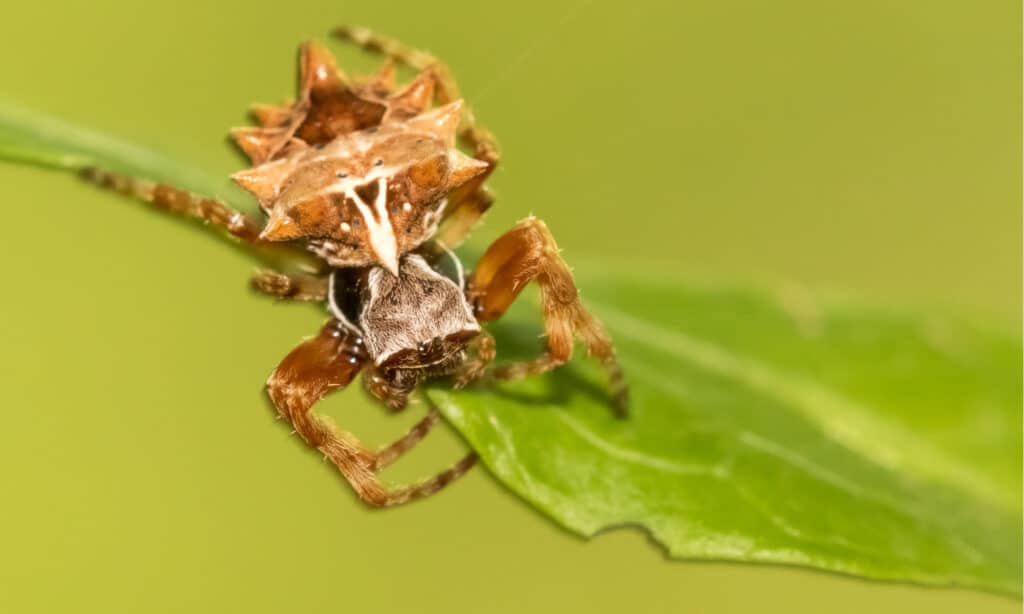
Orb weavers are common spiders in Illinois.
©Matthew W. King/Shutterstock.com
The biggest spiders in Illinois are not the largest that you’ll find in the U.S. Still, you can see some sizable creatures in this part of the country. We’re going to take a look at spiders that have a large body and leg span throughout this article. More importantly, we’re going to focus on how to identify them by sight and tell you whether they have a medically significant bite. With that said, let’s get down to business!
5. Long-Bodied Cellar Spider
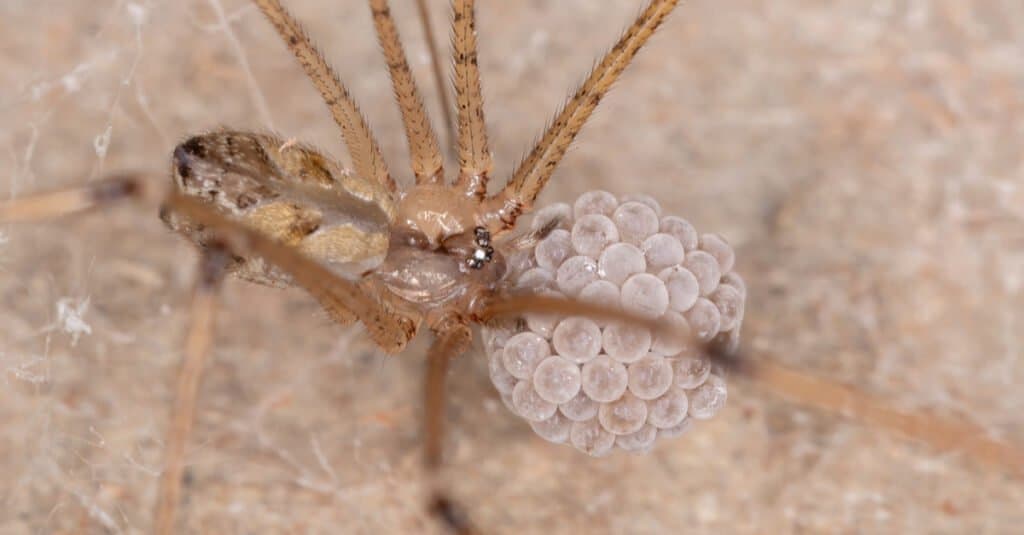
Cellar spiders have small, peanut-shaped bodies.
©iStock.com/ViniSouza128
| Scientific Name | Size | Danger to Humans |
|---|---|---|
| Pholcus phalangioides | 1-2 inches | A bite may cause a mild burning sensation. |
The long-bodied cellar spider is often confused with the harvestman because they have both been given the name Daddy Long Legs or Grandaddy Long Legs. That’s not problematic on its own, but these spiders are sometimes believed to be deadly as a result of that name confusion. To be clear, they are not.
In the rare event that one could be coaxed to bite, a bite from a cellar spider would cause a mild burning sensation and a little pain, nothing more. This spider looks scary, though. It has a semi-translucent body that is brown, gray, or a mix of the two colors. Moreover, it has long legs relative to its body and a habit of living in dark, spooky places like attics and basements.
Cellar spiders form webs, and they will make those webs vibrate if they feel that they’re in danger. While that can be scary, these spiders are nothing to worry about.
4. Forest Wolf Spider
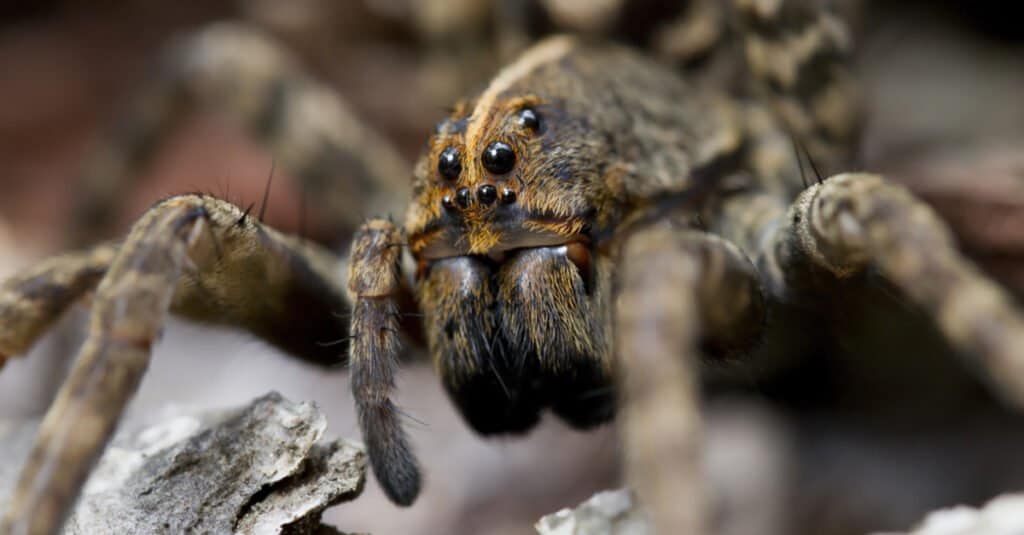
Forest wolf spiders measure about 2 inches in total length.
©Will E. Davis/Shutterstock.com
| Scientific Name | Size | Danger to Humans |
|---|---|---|
| Hogna frondicola | 0.5-2 inches | A bite will cause pain, itchiness, and swelling around the bite area. |
The forest wolf spider is a medium-sized member of the wolf spider family. Although most people think that they are very dangerous because of their large body size and speed, the truth is that they’re not. If they bite you, you’ll feel pain, swelling, and itchiness around the area.
Some people are allergic to this spider’s venom, and they may feel sick, get a headache, or have other symptoms that need to be checked by a doctor.
This spider is found wandering in a variety of areas, including overgrown fields and forests to houses. It is easily identified by its light brown or tan color, two dark marks on their carapace, and a light stripe that runs the length of the body. Its leg is darker near the body and banded with light and dark colors.
These spiders may scare you if you see them scurrying around your home, but they’re ultimately harmless in most cases.
3. Black and Yellow Garden Spider

The black and yellow garden spider is a common sight throughout much of the United States.
©iStock.com/AwakenedEye
| Scientific Name | Size | Danger to Humans |
|---|---|---|
| Argiope aurantia | 0.5-3 inches | Rarely bites humans, but it may cause pain and swelling. |
The black and yellow garden spider is also called the writing spider, corn spider, orb weaver, and many other names. It is known for silver cephalothorax and black and yellow markings on the abdomen that can sometimes include gray or silver. Its leg is long, with a brownish-red femur and banded black and brown tibia.
The spider is identifiable by its looks as well as its large web. The web can measure several feet in diameter and contains an extra thick section that looks like scribbled handwriting. This stabilimentum has led to this species being called the writing spider, and it probably serves several purposes.
These spiders live outdoors near fields in tall vegetation and around human settlements, high in the air. They may investigate human disturbances on their webs, but they rarely bite. A bite from this spider is mildly painful and leaves some swelling in the area.
2. American Nursery Web Spider
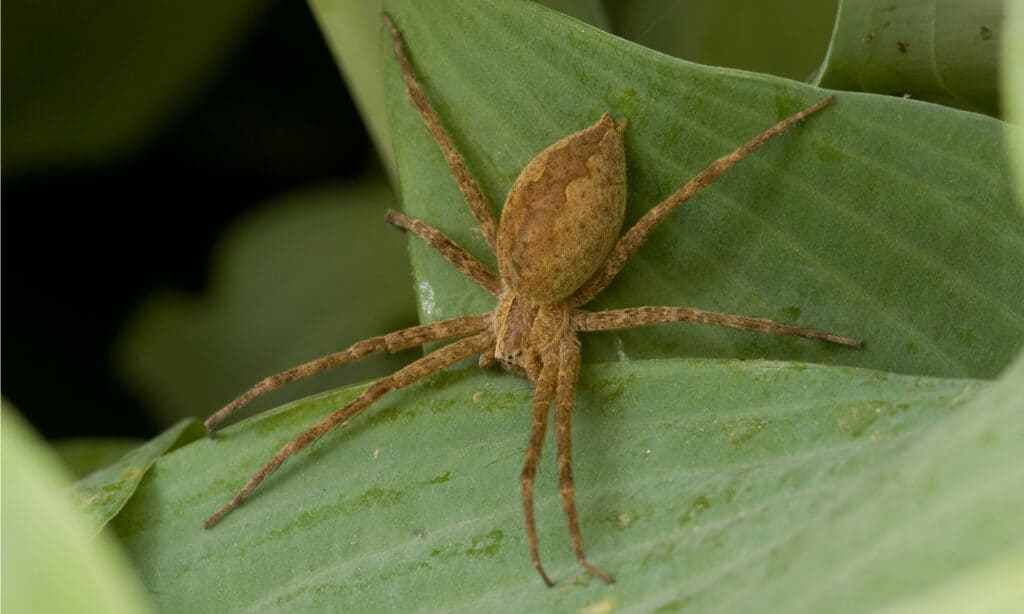
American nursery web spiders practice sexual cannibalism.
©SDeming/Shutterstock.com
| Scientific Name | Size | Danger to Humans |
|---|---|---|
| Pisaurina mira | 1-3 inches | Has a bite that is mostly harmless to humans, with pain and swelling common. |
The American nursery web spider is one of the biggest spiders in Illinois. This spider is very plain-looking, with a brown or brownish-red body, a brown pattern bordered by a light color running down the length of its body, and a dark brown pattern in the middle of its abdomen. The legs have bands in brown and light brown colors.
These spiders don’t bite very often, but they can cause mild pain and swelling when they do. You’ll mostly find this spider in tall vegetation and forests. Sometimes, they’ll set up their webs on the bushes, trees, and shrubs near a home.
These spiders are famous for their very maternal instincts. They build a nest for their young and then watch over the hatchlings.
1. Dark Fishing Spider
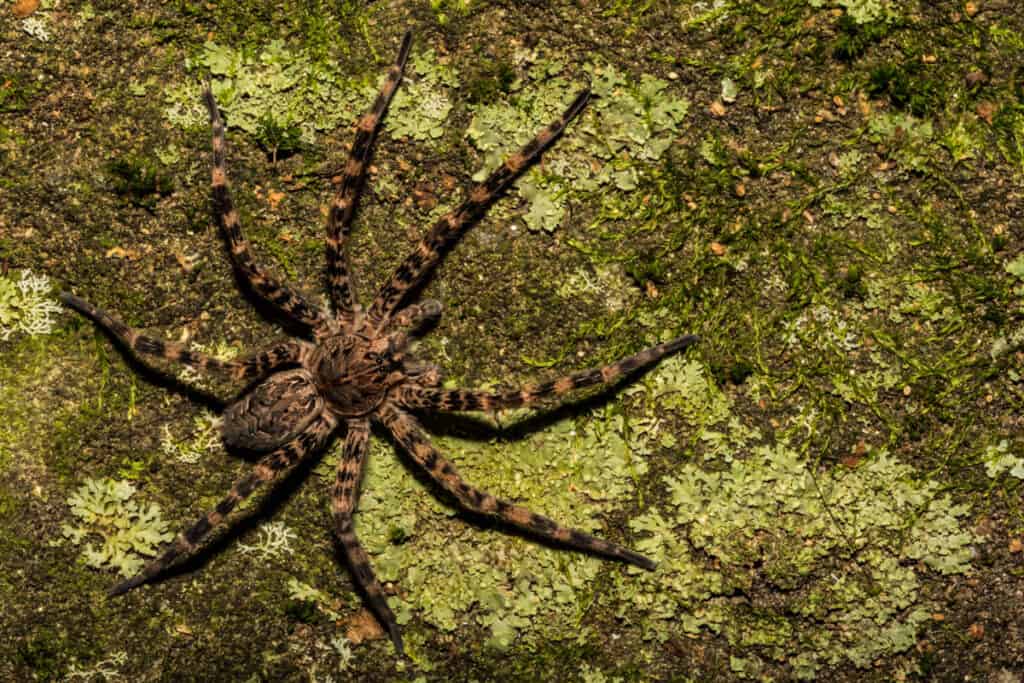
The dark fishing spider can run across the surface of the water or dive into the water to catch prey.
©iStock.com/JasonOndreicka
| Scientific Name | Size | Danger to Humans |
|---|---|---|
| Dolomedes tenebrosus | 3.5-4.5 inches | Can bite humans and cause a reaction similar to a bee sting. |
The dark fishing spider is the biggest spider in Illinois, measuring upwards of 4.5 inches in some cases. However, most of their size comes from their bodies, unlike other species like tarantulas.
This spider has a mottled brown and black body color, banded black and brown legs, and W-shaped markings on its abdomen. You may see this spider near the water, or you may see it on trees where they spend a lot of their time.
Although the size of this spider can be scary, the good news is that it is relatively harmless to people. It only bites if it feels threatened and can’t get away. Even then, the bite is similar to a bee sting in terms of pain and the body’s reaction.
Knowing the biggest spiders in Illinois, it’s a good idea to review the most dangerous ones. In this state, you need to watch out for the brown recluse and black widow spider. Both of these creatures can cause medically significant bites. You should consult medical professionals if you are bitten by either of them.
Summary of 5 of the Biggest Spiders in Illinois
| Spider | Size | |
|---|---|---|
| 1 | Dark Fishing Spider | 3.5-4.5 inches |
| 2 | American Nursery Web Spider | 1-3 inches |
| 3 | Black and Yellow Garden Spider | 0.5-3 inches |
| 4 | Forest Wolf Spider | 0.5-2 inches |
| 5 | Long-Bodied Cellar Spider | 1-2 inches |
The photo featured at the top of this post is © iStock.com/AwakenedEye
Sources
- Missoula Butterfly House (1970) missoulabutterflyhouse.org/forest-wolf-spider-hogna-frondicola/
- NC Extension, Available here: https://content.ces.ncsu.edu/black-and-yellow-garden-spider
- Missouri Department of Conservation (1970) mdc.mo.gov/discover-nature/field-guide/wolf-spiders
- Web MD (1970) webmd.com/a-to-z-guides/what-you-need-to-know-about-a-wolf-spider-bite#:~:text=Wolf spiders don't pose,it shouldn't last long
Thank you for reading! Have some feedback for us? Contact the AZ Animals editorial team.






